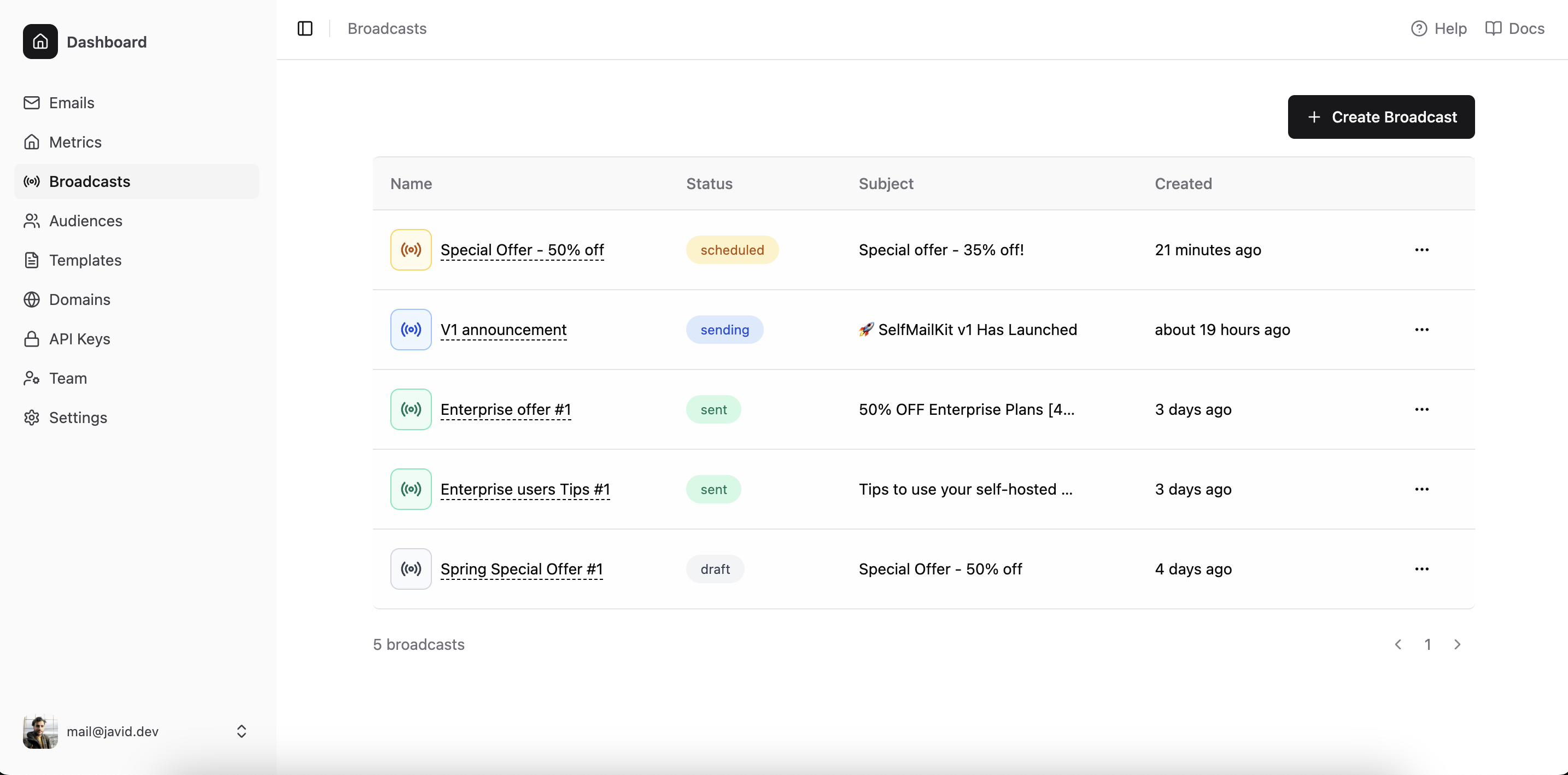Native Email Inbox - Receive and reply to emails
All-in-One Email Platform
Send transactional, marketing, and newsletter emails. Receive and reply with native inbox support.Cheapest email platform. Guaranteed

Testimonial Highlight
What our customers are saying
SelfMailKit's Managed Cloud offers a seamless, all-in-one email solution - combining sending, receiving, and powerful analytics with zero infrastructure hassle. Built on top of Amazon SES, it delivers a robust front-end backed by one of the most reliable and cost-efficient SMTP services available. Ideal for teams who want simplicity, scalability, and performance without the overhead.
Henry Timmes
I'd wrestled with overpriced, email platforms for too long and had never understood their extensive pricing models - until I discovered SelfMailKit. In under an hour, I had a fully-featured, SES-powered stack running on my own AWS account thanks to the product's one-command deployment and clear, step-by-step docs. Javid, its founder and developer helped personally to handle my specific questions and adjustments. Learnt a lot from his high quality code base.
Tobias Klemmer
Problem
Email platforms are expensive and bloated
Most email platforms charge high fees and come with unnecessary features. Learn why SelfMailKit is different from traditional email marketing platforms.
High Email Costs
Traditional email platforms charge excessive fees, with costs quickly escalating to $500+ per 100k emails.
Bloated Dashboards
Email platforms overload their interfaces with unnecessary features, making them confusing and difficult to navigate.
No Native Inbox
Most platforms only focus on sending emails, lacking native inbox capabilities for receiving and replying to emails.
Solution
The Cheapest Complete Email Platform
Send marketing campaigns, transactional emails, newsletters, and manage your inbox - all in one place
Marketing Campaigns
Create and manage email campaigns. Schedule newsletters and track performance.
Built-in Inbox
Native email inbox experience. Send, receive and reply to emails directly from the dashboard.
Transactional Emails
Real-time delivery stats, automated transactional emails with templates.
Visual Template Editors
Notion-like editor. Import HTML from other email builders.
Contact Management
Import contacts from CSV. Automatically update your contact list by using APIs.
Unlimited Domains
Add unlimited domains. Manage multiple projects in one place.
Team Collaboration
Invite team members. Create API keys, templates, and more with granular permissions.
Analytics Dashboard
Open/click tracking, bounce reports, and detailed delivery insights.
Production Ready
Highly scalable. Load tested for scale. Battle-tested infrastructure and code.
Developer Experience
The whole infra is coded. Almost zero maintenance (only bump Lambda Runtimes when major versions are released).
Event-driven Architecture
Queue management. Smart rate limiting and warm-up. Retry logic.
Email Authentication
DKIM setup, SPF configuration, DMARC support. Everything you need to comply with email regulations.
Security Features
Built on top of AWS Best Practices. DDoS/Bot protection. Secure authentication & authorization.
Monitoring & Logs
Real-time metrics. Detailed log of every email sent. Error alerts.
Dark & Light Mode
Choose between dark and light mode for your dashboard.

Swipe to explore more features
Explore detailed feature guides and latest updates
Migrate from other platforms
We help you to migrate from other platforms at no cost
Easy Setup
Choose your preferred setup type - Cloud, Connect, or Self-hosted. We guide you through the process.
Data Migration
We migrate your existing data from other platforms - templates, contacts, and settings.
Ready to Send
That's it! Start sending millions of emails at 10x lower costs.
Quick Integration
Start sending emails in minutes with our developer-friendly API
Choose Your SelfMailKit Type
SelfMailKit offers three options to match your needs. From fully managed to complete control.
Cloud
Fully managed email service with our infrastructure. No setup required.
- Managed email infrastructure
- No AWS account needed
- Simplest setup process
- All features included
Connect
Bring your AWS SES for even lower costs. Keep your email reputation.
- Ultra-low costs with your AWS SES
- Native inbox included
- Keep your email reputation
- Quick 2-minute setup
Self-hosted
Deploy the cheapest email platform on your infrastructure. Complete control.
- Native inbox functionality
- Complete infrastructure control
- Full source code access
Pricing
Dead simple pricing - one price for all email types
5k monthly emails is free, no credit card required
SelfMailKit
- Unlimited domains & audiences
- Managed email infrastructure
- Full feature access
- Native inbox & replies
Want to see more detailed pricing comparisons? Read our comprehensive pricing analysis.
Enterprise-Grade Security
SOC2-Aligned Architecture
Infrastructure designed with SOC2 Trust Service Criteria principles
AWS Well-Architected
Built on AWS security best practices with 99.99% uptime SLA
US Compliance Ready
CAN-SPAM Compliant
Built-in unsubscribe handling and email marketing compliance
Complete Audit Trail
Every email tracked with timestamps for compliance reporting
FAQ
Common questions
Everything you need to know about SelfMailKit.
Still have questions? Email us at support@selfmailkit.com
Start with SelfMailKit Cloud today
Get Started with Cloud →- Up to 80% email cost savings
- 5k emails per month free forever
- Unlimited domains, audiences & contacts
- Fast dedicated support included